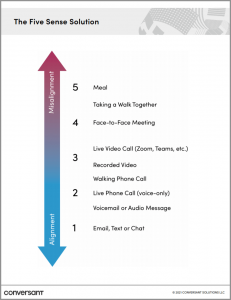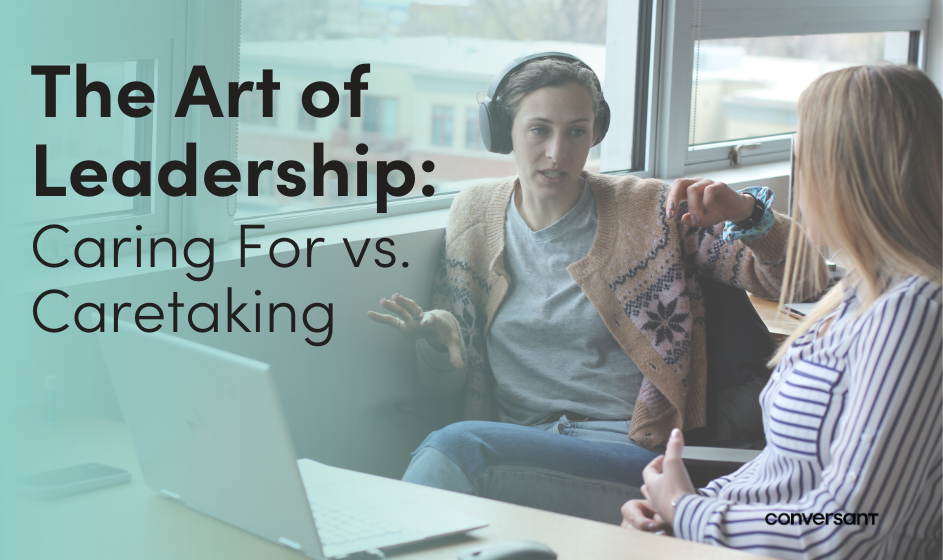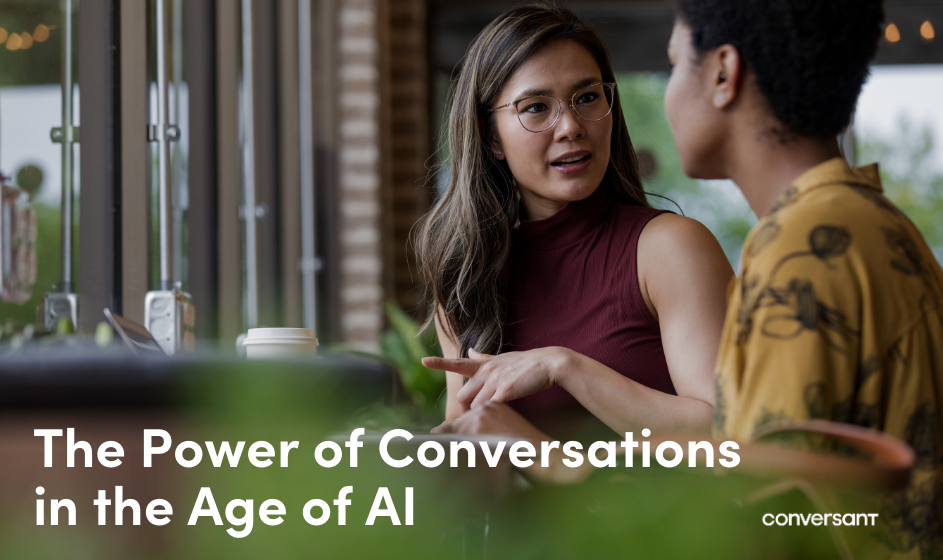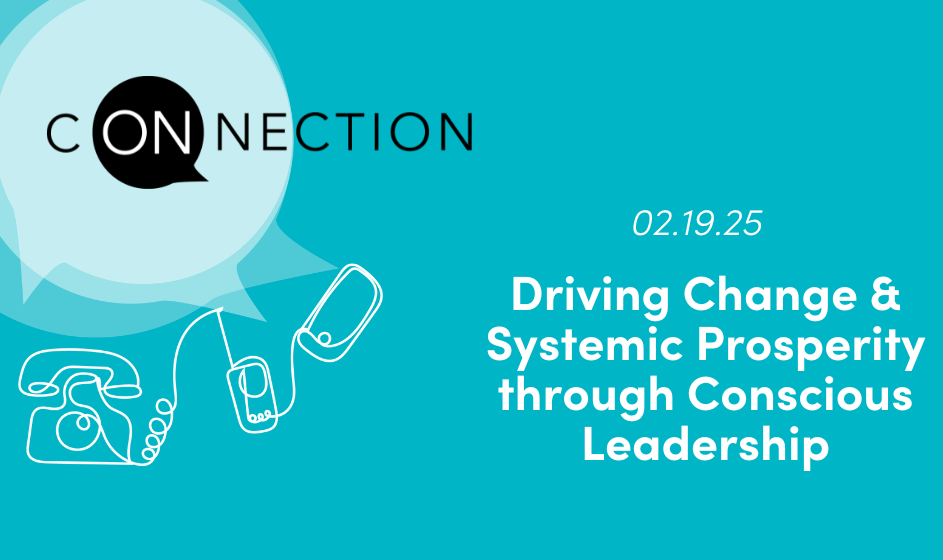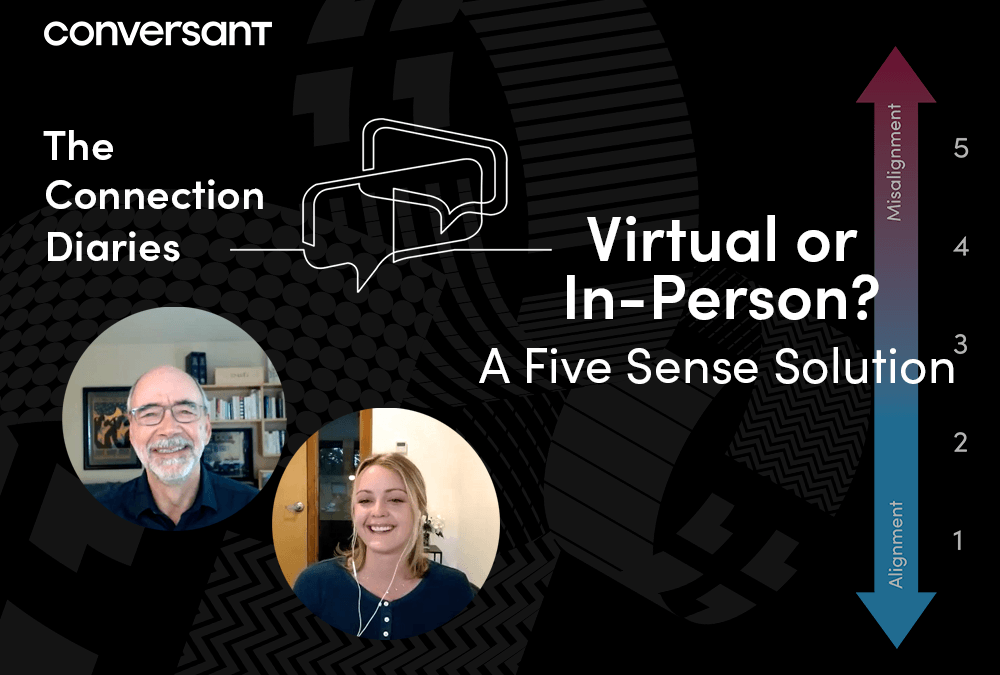
Virtual or In-Person? A Five Sense Solution | The Connection Diaries
As parts of the world begin to emerge from the COVID-19 pandemic, many are asking – should we be in person or stay virtual? Mickey Connolly has a simple principle for deciding which conversations should take place in which venue:
The greater the potential for disagreement, the more human senses you want engaged in the conversation.
In this month’s edition of the Connection Diaries, Mickey walks us through his “Five Sense Solution,” a tool he created over 15 years ago that’s even more relevant today. The pandemic only accelerated a trend that’s been emerging for decades; our technology-driven world allows us to communicate with minimal engagement of our human senses. It isn’t uncommon to have working relationships primarily mediated by chat platforms and Zoom, and in many ways these tools have expanded our capacity for cross-boundary collaboration and efficiency.
They are, however, just tools. No app or innovation can single-handedly help us accomplish all we need to with less time, money and stress. That takes discernment and design. The Five Sense Solution helps us leverage the best of each of these venues, from email to walking meetings, or even having dinner together.
You can find a full transcript of this video below and download a handout version of The Five Sense Solution to share with your team. Explore all past episodes of The Connection Diaries here or on our YouTube channel, and don’t forget to connect with us on LinkedIn.
Full Transcript
Emma Rose: Hello everyone, I’m Emma Rose Connolly. Welcome to another edition of The Connection Diaries. I’m joined today by Mickey Connolly, and we’re going to discuss a timely topic related once again to the world of virtual work that we’ve all been experimenting with over this last year plus now. The world is not at a new stage in this experiment. At least some parts of the world are starting to decide when we can be together and when we should be together. Turns out there’s actually a framework that Mickey came up with a very long time ago, about 15 years, correct? That very much applies to this. So I invited him to share why that might be relevant today and how it can help us be intentional in the design of our conversations as we move forward. So, would you like to share what that framework is about?
Mickey: Yeah, I’ll say a little summary of it and then you can decide where we go with this conversation. I like that you just put it into the context of design because I think the fundamental design principle when you’re looking at, in what kind of venue are we going to have an interaction, and I mean venues all the way from am I doing this in a text to are we having dinner together. And making that choice can be a choice about thoughtful design. The basic design principle is the greater the potential for disagreement, the more human senses you want engaged in the conversation. Said another way, the more important the alignment and the more in question that important alignment is then the more human senses you want engaged. We found that every sense you take away, the imagination fabricates things about the other person, about their mood, about their intention. Sometimes even about their character. And when you have all the senses engaged there’s less uninformed fabrication, so that’s the basic principle, that the greater the importance of the alignment and the potential for disagreement the more human senses you want in the conversation.
Emma Rose: Great. I think that’s something that we likely take for granted. Yes, we’ve over the last year dealt with not being in person and I’m sure many people have opinions about that and can share how that’s impacted their working life. But there are ways to actually be intentional about this and for particular conversations make it more of a priority. How would you tell somebody they could assess the level of alignment that they have with the person or the people they’re going to meet with?
Mickey: Well, we found if you’re looking at absolutely full alignment, which means you could do extraordinary things through text and email, that people will be aligned in four different areas. One is values, that the fundamental way they look at whatever they’re doing together, whatever principles it’s based on, like for us at Conversant the notion of an open and authentic conversation is huge. So, if someone was sharing that value then you’re aligned at the level of values.
Then there’s purpose. Are we aligned for the meaningful reason we’re doing what we’re doing? Then there’s process or method. Are we aligned about how we’re going to do it? And then result, are we aligned on what we’re trying to produce and by when. So the full alignment’s got those four dimensions to it, which is values, purpose, methods, and results.
And we invite people when you’re looking at a design to assess those on a scale of one to one hundred and just say, how aligned are we regarding values? I might say, it looks to me like it’s about 75. Write down a few words about what has me say that. I could do the same thing with the other three, with purpose, process, and results. Have somebody else who’s working with you on the design do the same thing, explain your rating to one another, and the sense of how aligned we are relative to the need. It will become obvious in the conversation.
Emma Rose: Well, it’s coming to mind too that it might be nice to, when it’s possible, I know it isn’t always possible, to invite someone into that conversation whether it’s the person you want to connect with or maybe someone who might have some perspective, to help you decide if it’s on a scale from 1 to 100 because I could imagine us assuming a certain level of alignment in terms of values or even purpose, and then once we get to the important conversation and we have fewer senses engaged and there is a big misalignment, it causes more trouble than was absolutely necessary.
Mickey: I think one of the safety nets for this is to never have the design conversation as a solo venture. I need more perspectives and you’re saying the idea which is the very people who have to be in the interaction are co-creating the design, and that’s why it’s good for each person individually to say how would I assess this on a scale of one to 100 and then you explain it to one another and in the learning, we reveal what the gap is between the need for alignment and the current state.
Emma Rose: So within this set of principles that we call The Five Sense Solution, it goes all the way up to have a meal together, as you said. Why do you think that’s something that’s important? I think it’s something we probably treat as a throwaway. It’s fun, of course, to expense a dinner and go hang out and maybe throw back a few glasses of wine, but that it might actually serve a larger purpose.
Mickey: I’d like to get to that by just talking a little bit about the stages. So we talk about The Five Sense Solution, as in human senses, and you add a sense every time you need to assure the environment in which the alignment can happen. And that’s why I said earlier there are things you can do via chat or email, however, have you ever tried to resolve an argument via chat or email? Most people say that doesn’t go so well. And it’s because the level of disagreement doesn’t fit the amount of senses you have in there. And we fabricate all sorts of mischievous things about each other. And you can move up the ladder if you decide that we definitely need more than that. Then you’re going to add some sort of audio experience, all the way from voicemail to a walking meeting, where I’m out walking and you’re out walking but we’re listening to each other and talking to each other, so we get an audio sense. Above that, you add vision to all that, where we’re doing something like we’re doing here.
The dinner thing is whenever you really need to have people be fully human together, and I know that can sound a little strange. The time that I originally got really inspired by this I’ll explain first by reading a quote from someone who I respect.
“I believe there’s no such thing as a conflict that cannot be ended. They’re created and sustained by human beings. They can be ended by human beings. No matter how ancient the conflict, no matter how hateful, no matter how hurtful, peace can prevail.”
That was George Mitchell in the words that he used when he was accepting the Presidential Medal of Freedom after the success of the Good Friday Accords that ended 30 years of civil war in Northern Ireland. And one of the things that I admired about what he did is he recognized that it’s humans that solve this. How much humanity do we need to bring to the challenge? 30 years of civil war, that would take a lot of humanity, and he did something I found extraordinarily wise. He asked the members of the two warring factions, those representatives, prior to the formal resumption of negotiations, to spend a weekend in the countryside in Ireland with him with the agreement that throughout the weekend they would share all their meals and there would be no discussions of what they called “the troubles.” So no conversation about the negotiations, and yet they had all their meals together through that weekend.
It was really an amazing chance to just be humans with each other and, yes, it started out pretty superficial, talking about things like sports and weather. But when you’re having half a dozen meals together that wears out as topics of discussion, and they ended up each sharing things about their family. And by the time they got to Monday morning, there was an extraordinary intersection where they had all honestly shared their fears given the hundreds of deaths that had happened around them, about the dangers that their children were in, the dangers that their family at large were in. And that gave a completely different foundation for the resumption of those negotiations.
Now, a lot went on after that, but there are many people who say when the Accords were finally inked and what’s called The Mitchell Principles ran them, that people’s availability to even create the negotiation principles started at those dinners.
So that’s an example now for us who are not managing a resolution of a 30-year civil war. The question simply is, is it time for us to be together because the stakes are so high that it’s worth investing in this? So just last week with a client, we’d been working on a project remotely for a year and it got way down the road, a lot of progress. However, there were some really basic strategic questions for this company that needed to be answered and it was beginning to be difficult to manage it virtually. The CEO said, how about we make sure everybody’s vaccinated, and we actually get together and do this in person. I thought he was impeccably appropriate. We had that meeting, two half-day sessions and a dinner. We got more done than I think we could have done in 10 sessions virtually. It was just time because the stakes were high, the people needed to be with each other in a way that evokes the kind of trust that immediate perception can create. So you don’t have to wait for war to have dinner be a wise move in the domain of well-designed alignment.
Emma Rose: Well, I like that you bring up the limits of virtual, because I think that’s something that we actually spoke about very early on, one of our first Connection Diaries videos, about what’s the purpose of your being together, what do you need the results of that conversation to be, and then to design backwards from that whether or not being in person is really necessary. This framework gives you a bit of a deeper dive into how to design that and how to make those decisions, but virtual is wonderful. It’s been really great for certain things. I think we’ll continue to do some virtual work with clients for the rest of the time that this company exists. But hat there are times when we do just, we will benefit from being in person.
Also, the role of humanity as you mentioned. A lot of people have said over the last year that we’ve gotten a dose more of people’s humanity, getting to see into their homes, see their children and their dogs and their cats on their lap, running through the background. We’ve had a lot more generosity for people’s limitations in working from home, but as we were talking about the other day, I personally believe, and we’ll see, I can’t predict the future, but that’s novel for now, and then as soon as that novelty wears off the humanity of being in person is going to be what we’re lacking and we’ll need some sort of return back to that, too.
Mickey: I think there are so many people trying to answer this question, about can we remain entirely virtual, if not what’s the hybrid solution. I think one thing to be really careful of is, I’ve seen a lot of people get into conflicts about this question already, and they start with their personal preferences, making a case for why we should all do the thing I like better. So some people are saying it’s hard for me to be at home and not have the separation between work and home, it was fine in the beginning but now it’s a source of stress on my family, I want to go in. Other people are going, hey I don’t need to go in there, I love being at home. I’m not going in. Alright, well what if we stop, took a breath, and both of us just let go of the grip on our preferences and had a design conversation about what’s at stake. What’s the state of alignment relative to that purpose? What are the venues for which conversation?
So even the one I talked about last week that was so successful, for the two weeks before we had some really effective virtual conversations that set us up for that. However, they were the ones that the level of alignment allowed. So, I just think have this be a design conversation, not an argument about personal preferences. Our preferences are always there in the background, I just don’t think they rule when the stakes are high.
Emma Rose: Or they might not be servicing what we’re in together.
Mickey: Yeah, that’s what we need to be focused on if it matters. That’s a really good point if we’re in a war of preferences, what’s the thing we’re in together?
Emma Rose: Well, thank you so much. I think this will be valuable to many. I know that we think about it all the time and we’ll include a downloadable version of that solution here so you can take that, use it yourself, share it with your teams. Let us know what you think. Also, as always, please let us know if there’s a topic that is in your working life right now that you would like us to address. We like to hear from you guys. And until next time… I don’t know, until next time. (laughter)
Mickey: Yes, we keep discovering what’s going to happen in life, I don’t know either but I know we’re happy that you join us so thanks for doing that.
Emma Rose: Absolutely. Thank you, bye.

